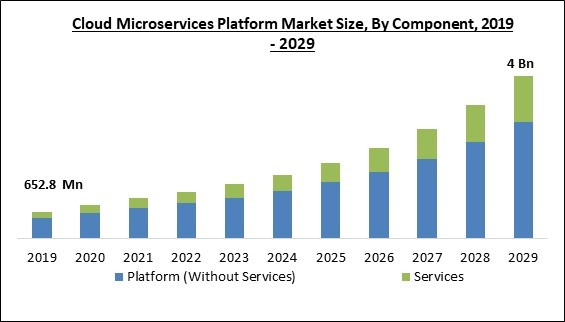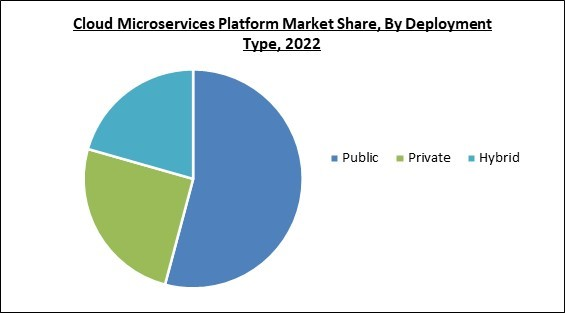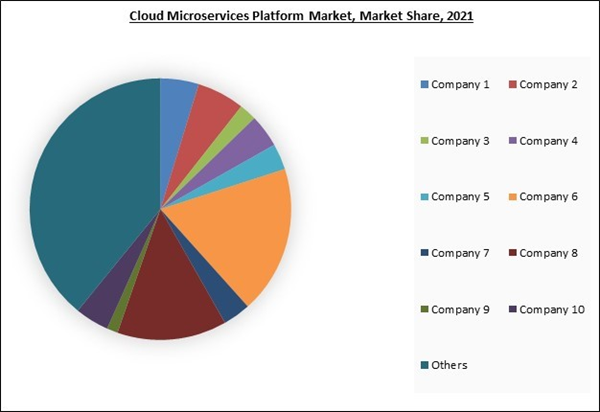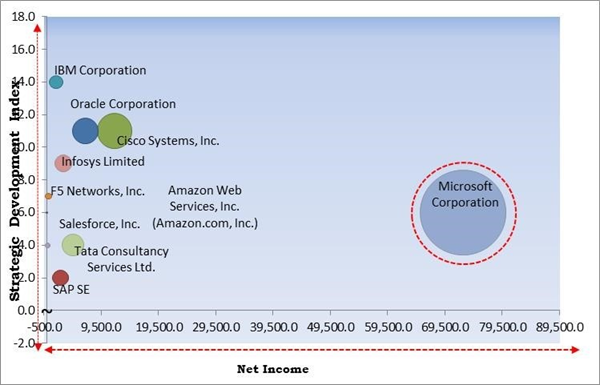The Global Cloud Microservices Platform Market size is expected to reach $4 billion by 2029, rising at a market growth of 20.1% CAGR during the forecast period.
A cloud microservices platform is a collection of technologies, tools, and services that enable developers to create, deploy, and maintain microservices-based software. An application is divided into smaller, independent services called "microservices," each with unique features. This technology is essentially a software development methodology. The development and deployment of these services are separate, and they can interact with one another utilizing APIs.
Executives and project managers favor microservices as much as developers do. Given that architectural enthusiasm is normally reserved for software development teams, this is one of the more unique qualities of microservices. This is because the way most business leaders desire to organize and manage their teams as well as development processes is better reflected by microservices. The fact that changing a line of code or adding a new feature to an application no longer necessitates a congressional act may be the single most significant aspect of microservices. This is because the services are independently deployable and smaller.
Organizations might expect an antidote from microservices to the visceral annoyances brought on by modest adjustments taking a long time. Creating cross-functional teams around a service, product, or business issue is a typical emerging organizational approach. Because it allows an organization to build small, cross-functional groups around a single service or a group of services and also has their function agilely, the microservices model fits in well with this trend.
The leading players in the market are competing with diverse innovative offerings to remain competitive in the market. The illustration shows the percentage of revenue shared by some of the leading companies in the market. The leading players of the market are adopting various strategies in order to cater demand coming from the different industries. The key developmental strategies in the market are Partnerships & Collaborations.
The major strategies followed by the market participants are Partnerships. Based on the Analysis presented in the Cardinal matrix; Microsoft Corporation are the forerunners in the Cloud Microservices Platform Market. Companies such as IBM Corporation, Oracle Corporation, and Cisco Systems, Inc. are some of the key innovators in Cloud Microservices Platform Market.
The market research report covers the analysis of key stake holders of the market. Key companies profiled in the report include Oracle Corporation, IBM Corporation, Infosys Limited, Cisco Systems, Inc., Tata Consultancy Services Ltd., Amazon Web Services, Inc. (Amazon.com, Inc.), SAP SE, Microsoft Corporation, F5 Networks, Inc., and Salesforce, Inc.
A cloud microservices platform is a collection of technologies, tools, and services that enable developers to create, deploy, and maintain microservices-based software. An application is divided into smaller, independent services called "microservices," each with unique features. This technology is essentially a software development methodology. The development and deployment of these services are separate, and they can interact with one another utilizing APIs.
Executives and project managers favor microservices as much as developers do. Given that architectural enthusiasm is normally reserved for software development teams, this is one of the more unique qualities of microservices. This is because the way most business leaders desire to organize and manage their teams as well as development processes is better reflected by microservices. The fact that changing a line of code or adding a new feature to an application no longer necessitates a congressional act may be the single most significant aspect of microservices. This is because the services are independently deployable and smaller.
Organizations might expect an antidote from microservices to the visceral annoyances brought on by modest adjustments taking a long time. Creating cross-functional teams around a service, product, or business issue is a typical emerging organizational approach. Because it allows an organization to build small, cross-functional groups around a single service or a group of services and also has their function agilely, the microservices model fits in well with this trend.
COVID-19 Impact Analysis
Cloud microservices solutions provide these advantages by offering discrete, modular services that are simple to integrate and expand as needed. Technology providers and suppliers increased their investment during the pandemic in developing cloud-based microservices platforms. The pandemic, however, also forced many enterprises to cut back on spending, which slowed the uptake of new technologies. Other reasons why some businesses might be reluctant to engage in cloud microservices platforms include worries about data privacy and security in the cloud during the post-pandemic period. As a result, the pandemic had an overall favorable impact on the market.Market Growth Factors
Rising demand for scalable solutions by most enterprises
The advantages of cloud microservices platforms for scalability are substantial. Microservices architecture, unlike conventional monolithic systems, offers far better flexibility and scalability by splitting complicated programs into smaller, independent services. Instead of having to expand a complete program at once, businesses can scale single services as needed with microservices. Businesses can also better adapt to changes in usage or demand patterns owing to this scalability. For instance, it is simple and rapid to scale up a service that is seeing a spike in traffic without disrupting other services in the system. Therefore, the increasing demand for scalable programs among industries is propelling the growth of the market throughout the forecast period.Increasing cloud microservices platform digital transformation
Scalability, agility, cost-effectiveness, adaptability, and DevOps drive the demand for cloud microservices platforms. Such platforms are growing in popularity among businesses as they aid in modernizing their IT infrastructure and promote digital transformation. Speed and agility are essential for firms to remain competitive in the digital economy. Applications can be developed and deployed more quickly with the help of microservices-based architectures, enabling companies to react more quickly to shifting market demands. This method enables developers to work on several program components concurrently, resulting in shorter development cycles. Such factors are boosting the expansion of the market.Market Restraining Factors
Security issues with the cloud microservices platform
Platforms for cloud microservices mainly rely on resource sharing, which, if handled improperly, can lead to vulnerabilities. It may also be challenging to monitor and secure every system component because of its distributed and decentralized nature. Cloud microservices platform companies must put strong security measures in place to solve these issues and guarantee that customer data is safeguarded. These methods should include encryption, access limits, monitoring, and logging techniques. Therefore, during the forecast period, security remains the main reason that is expected to limit market expansion.Component Outlook
Based on component, the cloud microservices platform market is categorized into platform (without services) and services. The platforms (without services) segment garnered the highest revenue share in the cloud microservices platform market in 2022. The expansion of this segment is being driven by the rising demand for scalable and agile software design and deployment solutions. Developers can test, build, and deploy applications more rapidly and effectively owing to the modular architecture provided by cloud microservices platforms.The leading players in the market are competing with diverse innovative offerings to remain competitive in the market. The illustration shows the percentage of revenue shared by some of the leading companies in the market. The leading players of the market are adopting various strategies in order to cater demand coming from the different industries. The key developmental strategies in the market are Partnerships & Collaborations.
Deployment Type Outlook
On the basis of deployment type, the cloud microservices platform market is divided into public, private, and hybrid. The hybrid segment recorded a significant revenue share in the cloud microservices platform market in 2022. The segment is being driven by higher adoption of hybrid clouds across various end-user sectors since many businesses are now at varying levels of cloud adoption. As a result, their ability to experiment with new goods and business strategies is greatly increased by the hybrid cloud. In addition, the demands placed on the data center changed as IT's function expanded.Application Outlook
Based on application, the cloud microservices platform market is segmented into data analytics, database applications, customer relationship management, and others. The data analytics segment witnessed the maximum revenue share in the cloud microservices platform market in 2022. The expansion of the data analytics segment is driven by enterprises' growing need to process and analyze enormous amounts of data in real-time. In addition, data generated by organizations has surged due to the development of digital devices and the Internet of Things (IoT) expansion. Customers, sensors, social media, and other devices are just a few examples of the sources from which this data may flow.End-user Outlook
On the basis of end user, the cloud microservices platform market is classified into BFSI, IT & telecommunications, government, healthcare, retail & e-commerce, manufacturing, and others. The manufacturing segment acquired a substantial revenue share in the cloud microservices platform market in 2022. The segment is growing due to the rising demand for cloud-based microservices in manufacturing. For example, pay-as-you-go serverless computing and microservices models from AWS (Amazon Web Services) reduce the cost of operating connected manufacturing facilities or smart product programs with little upfront investment and nearly infinite on-demand capacity.Regional Outlook
Region wise, the cloud microservices platform market is analyzed across North America, Europe, Asia Pacific, and LAMEA. The North America segment witnessed the largest revenue share in the cloud microservices platform market in 2022. The expansion is due to the region's considerable commercial presence and the increased usage of cutting-edge postal technologies. In addition, businesses are adopting automation due to increased labor costs and a lack of manpower, expanding the market. The region's postal automation industry is growing due to the growing demand for these services from the government, BFSI, and other industries.The Cardinal Matrix - Cloud Microservices Platform Market Competition Analysis
The major strategies followed by the market participants are Partnerships. Based on the Analysis presented in the Cardinal matrix; Microsoft Corporation are the forerunners in the Cloud Microservices Platform Market. Companies such as IBM Corporation, Oracle Corporation, and Cisco Systems, Inc. are some of the key innovators in Cloud Microservices Platform Market.
The market research report covers the analysis of key stake holders of the market. Key companies profiled in the report include Oracle Corporation, IBM Corporation, Infosys Limited, Cisco Systems, Inc., Tata Consultancy Services Ltd., Amazon Web Services, Inc. (Amazon.com, Inc.), SAP SE, Microsoft Corporation, F5 Networks, Inc., and Salesforce, Inc.
Recent Strategies Deployed in Cloud Microservices Platform Market
Partnerships, Collaborations and Acquisitions:
- Apr-2023: Infosys teamed up with LexisNexis, a data and analytics company. The collaboration aims to offer end-to-end information services in their spectrum of enterprise, content and product applications. Moreover, Infosys would make sure continued delivery excellence, while allowing LexisNexis to smoothly meet expected cost optimization business outcomes and objectives.
- Feb-2023: Infosys came into partnership with ng-voice, a complete containerized and cloud-native IMS solution provider for the telecom market. Under this partnership, the companies would work together for delivering exceptional managed services and cloud-native software solutions while promoting innovation and providing tailored customer experiences to ng-clients.
- Feb-2023: Amazon Web Services collaborated with Intellect Design Arena, a FinTech company for financial and insurance institutions. Following this collaboration, Amazon Web Services would boost Intellect’s Go-To-Market strategy around co-market, co-build and co-sell for Intellect AI, the insurance and wealth line of business, with AI products developed for commercial underwriting, capital and wealth markets.
- Feb-2023: Microsoft partnered with Amdocs, a provider of software and services to media and communications companies, to announce a latest customer engagement platform. The platform would empower service providers to enhance their engagement and end-user experiences and journeys in all channels and applications.
- Feb-2023: Microsoft collaborated with Infosys, an Information Technology company based in India. This collaboration helps boost enterprise cloud transformation journeys globally. The alliance would benefit enterprises by bringing the best of Infosys Cobalt cloud portfolio and Microsoft's cloud computing technologies.
- Oct-2022: Oracle partnered with HSBC, a financial services company, to boost the bank's digital transformation. Under this partnership, HSBC would upgrade and migrate select database systems to Oracle Exadata Cloud customer, a cloud platform providing a managed infrastructure service in HSBC's own data centers.
- Aug-2022: Oracle collaborated with Anaconda, a provider of the world’s most popular data science platform. With this collaboration, Oracle focused on enabling and embedding Anaconda’s repository into Oracle Cloud Infrastructure to provide protected open-source Python and R packages and tools. The collaboration provided data scientists with streamlined access to Anaconda, delivering high-performance machine learning and assisting them to ensure strong enterprise security and governance.
- May-2022: Amazon Web Services collaborated with IBM, an American multinational technology corporation. Through this collaboration, AWS aimed to enable IBM to provide a wide range of its software catalog as Software-as-a-Service (SaaS) on AWS. Moreover, the collaboration helped the customers of both companies in enhancing their modernization to the cloud and consuming IBM Services in a cloud-native manner on AWS.
- Feb-2022: Amazon Web Services, Inc. came into an agreement with UST, a digital transformation solutions company. With this agreement, UST would invest in extending its deep AWS and enterprise digital transformation expertise to build for financial services, telecom and healthcare. Moreover, Customers would benefit from long-time of UST enterprise experience in legacy modernization from mainframe to AWS, DevSecOps transformation and microservices and reimagining UI experience.
- Dec-2021: Microsoft joined hands with Temenos, the banking software company, to meet the rising demand from banks for SaaS and banking services delivered by the Temenos’ Banking Cloud. This collaboration would develop financial services portfolio in the cloud to propel scalability, innovation and operational efficiency.
- Nov-2021: Tata Consultancy Services announced expanded partnership with Celcom, a provider of telecommunications in Malaysia. In this partnership, TCS would allow Celcom to further improve its digital and platform positioning from advanced digital capabilities including an enterprise product catalogue, AI/ML-driven business simulations, and partner ecosystem enablement.
- Jun-2021: IBM collaborated with GK Software, a cloud services vendor. Under this collaboration, the companies aimed to accelerate advanced and cutting-edge retail built over the hybrid cloud technology from Red Hat and IBM. Moreover, this collaboration would also help businesses quickly innovate and adopt the digital era.
Product Launches and Product Expansions:
- Feb-2023: Oracle announced the launch of Oracle Banking Cloud Services, the latest portfolio of composable, components cloud-native services. The launch delivers the ability to process scalable corporate demand deposit accounts, process real-time ISO20022 worldwide payments, and manage enterprise-wide limits. Additionally, the suite would support banks in modernizing and updating their business capabilities more rapidly and safely as they are created on a microservices architecture.
- Dec-2022: F5 released F5 distributed Cloud App Infrastructure Protection (AIP), a cloud workload protection solution that broadens application protection and observability to cloud-native infrastructures. The launch fills a critical requirement for customers to find a way to enlarge robust security controls to various cloud infrastructures where they run their latest applications.
- Jun-2022: Infosys unveiled the Equinox platform. This product launch aimed to aid businesses in delivering secure personalized and hyper-segmented omnichannel commerce experiences to B2B as well as B2C customers.
- Sep-2021: Cisco unveiled AppDynamics Cloud, a cloud-native observability platform for the latest applications that are based on highly complex, distributed services and architectures. The product is designed for intuitiveness, simplicity, and usability, it strengthens IT teams to provide exceptional digital experiences currently by end users, businesses, and consumers.
Acquisitions and Mergers:
- Jan-2022: Oracle took over Federos, a leading provider of cloud-enabled, AI-optimized network assurance, analytics, and automation software. With this acquisition, Oracle focused on empowering service providers with AI-optimized service and network analytics, assurance, and automated orchestration.
- Feb-2021: Cisco completed the acquisition of IMImobile, a leading global provider of cloud communications software and services. This acquisition aimed to integrate IMImobile’s solution along with Webex Contact Center, to design a new robust Customer Experience as a Service offer. Additionally, this suite would combine artificial intelligence, collaboration, Communications, cloud contact center, and experience management as a Service to generate a single solution that would give the enterprise the capability to deliver the exceptional experiences consumers require.
- Jan-2021: Cisco took over Banzai Cloud, a privately held company headquartered in Budapest, Hungary. Through this acquisition, the Banzai Cloud team would expand Cisco’s expertise and abilities through its demonstrated experience with the entire end-to-end cloud-native application, deployment, runtime, development, and security progress.
- Jan-2021: IBM signed an agreement to acquire Taos, a leading cloud professional, and managed services provider. Under this acquisition, Taos in-depth expertise, innovation solution, and public cloud partnership would propel the adoption and growth of IBM's hybrid cloud platform across America. Additionally, Taos provides organizations to select from the various provider for IT and business needs as well as consumers to successfully trace open hybrid cloud journeys along with providers.
Scope of the Study
By Component
- Platform (Without Services)
- Services
By Deployment Type
- Public
- Private
- Hybrid
By Application
- Data Analytics
- Database Applications
- Customer Relationship Management
- Others
By End-user
- IT & Telecommunications
- BFSI
- Government & Healthcare
- Healthcare
- Manufacturing
- Retail & eCommerce
- Others
By Geography
- North America
- US
- Canada
- Mexico
- Rest of North America
- Europe
- Germany
- UK
- France
- Russia
- Spain
- Italy
- Rest of Europe
- Asia Pacific
- China
- Japan
- India
- South Korea
- Singapore
- Malaysia
- Rest of Asia Pacific
- LAMEA
- Brazil
- Argentina
- UAE
- Saudi Arabia
- South Africa
- Nigeria
- Rest of LAMEA
Key Market Players
List of Companies Profiled in the Report:
- Oracle Corporation
- IBM Corporation
- Infosys Limited
- Cisco Systems, Inc.
- Tata Consultancy Services Ltd.
- Amazon Web Services, Inc. (Amazon.com, Inc.)
- SAP SE
- Microsoft Corporation
- F5 Networks, Inc.
- Salesforce, Inc.
Unique Offerings
- Exhaustive coverage
- The highest number of Market tables and figures
- Subscription-based model available
- Guaranteed best price
- Assured post sales research support with 10% customization free
Table of Contents
Chapter 1. Market Scope & Methodology
Chapter 2. Market Overview
Chapter 3. Competition Analysis - Global
Chapter 4. Global Cloud Microservices Platform Market by Component
Chapter 5. Global Cloud Microservices Platform Market by Deployment Type
Chapter 6. Global Cloud Microservices Platform Market by Application
Chapter 7. Global Cloud Microservices Platform Market by End User
Chapter 8. Global Cloud Microservices Platform Market by Region
Chapter 9. Company Profiles
Companies Mentioned
- Oracle Corporation
- IBM Corporation
- Infosys Limited
- Cisco Systems, Inc.
- Tata Consultancy Services Ltd.
- Amazon Web Services, Inc. (Amazon.com, Inc.)
- SAP SE
- Microsoft Corporation
- F5 Networks, Inc.
- Salesforce, Inc.
Methodology

LOADING...












